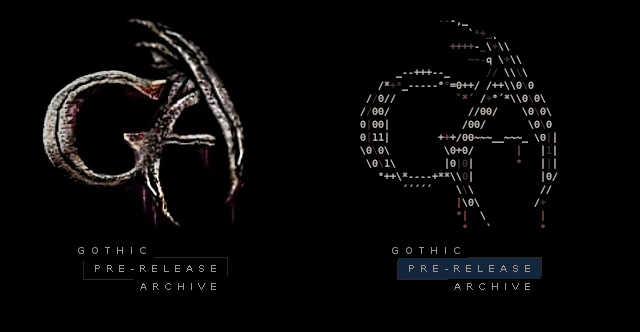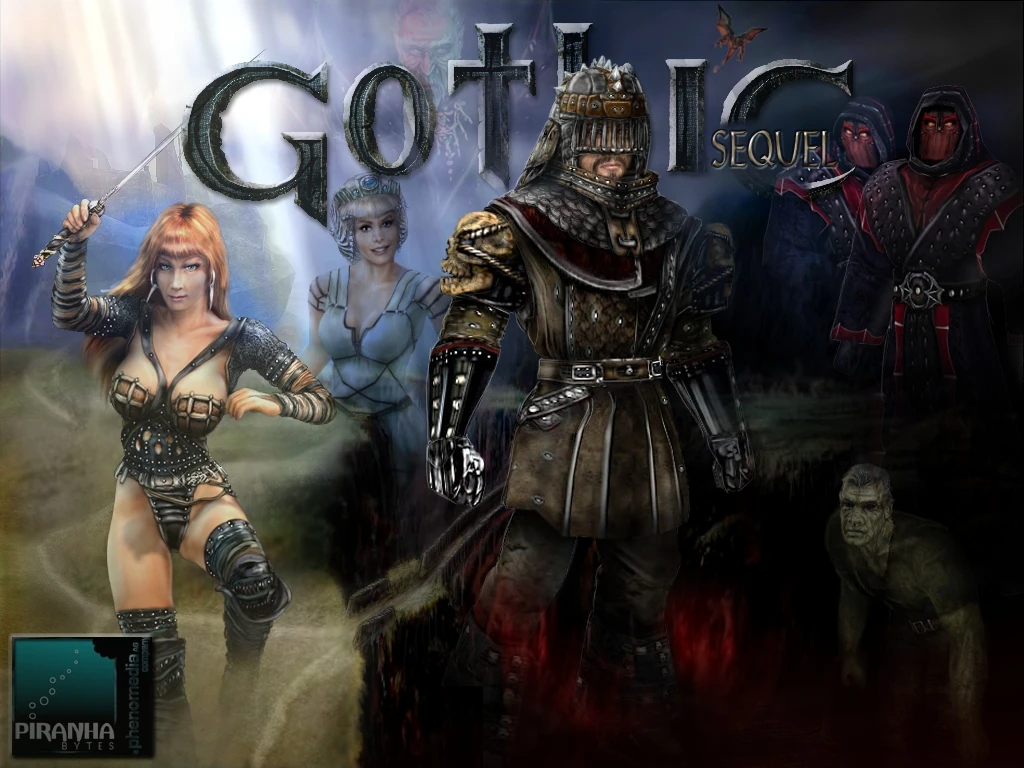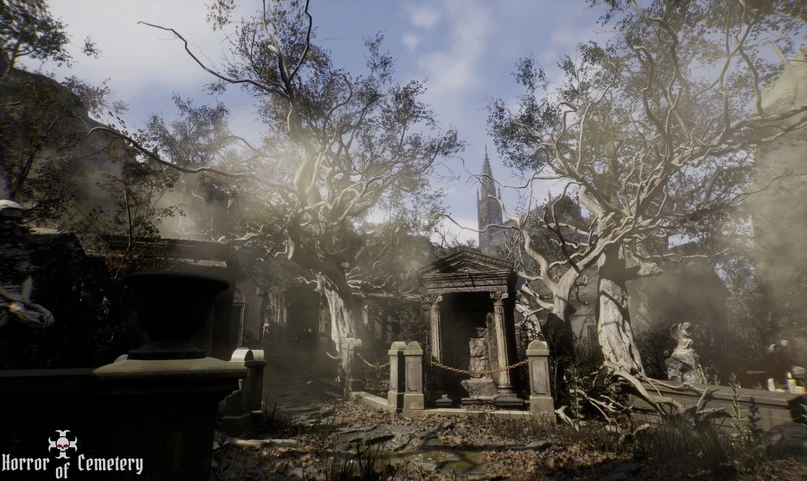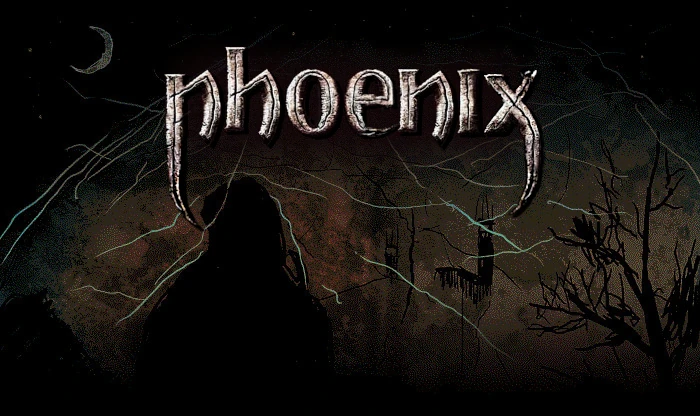
The second part of a series of interviews with Gothic Alpha passionates. This week I talk with Flosha, the creator of the Phoenix Tales project. It aims to create a game that would realise the early concepts of the creators of the first part of Gothic. From the interview you will learn why Gothic 2 is so different from the first part. You will learn about the framework and history of the Phoenix project. And also the previously undisclosed background of the Sequel leak.
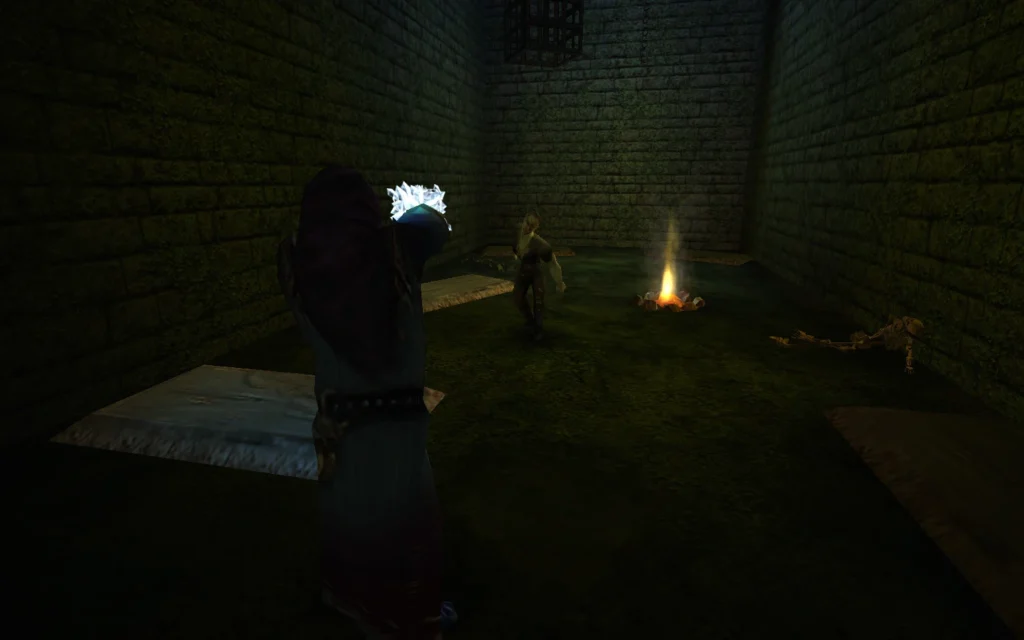
INterview
1. How it happened, that you started to research the previous versions of Gothic? Getting as many informations as possible was an aim itself, or did you need it to another aim?
I started to research the old versions for Phoenix. Issues, another german modder, started with the project “Orpheus” and I initiated another project, that was focused on a recreation of the Sequel and was meant to be linked to Orpheus. Later he stopped working on Orpheus and I took over and started from scratch. The two seperate projects were then merged into one project: Phoenix.
The pre-release material of Gothic is so extensive, that it can be very overwhelming and we had to have an overview and get some kind of order in this chaos. That is why I started to create the Gothic Archive, which at first was just an internal archive of pre-release material. Then I made a website out of it and published it. In course of the years I got into contact with Mike Hoge whom I visited to digitise his design documentation and concept arts and many other former developers contributed to the archive.
While the Gothic Archive is our collection of all the available material, we are now doing extensive research and analyses of said material in form of our Phoenix Docs. So why do I research Gothic? Because of this project that I want to realise.
2. On Gothic Archive site, on which we can find the most informations about the previous versions of Gothic, or on another sites, you can read mainly about the versions like 0.56c, 0.64b, 0.94k, 1.00b and the most often about 1.12f, i.e. Sequel.
Why just those versions are so interesting? By numering convention we can deduce, that there were a lot of more of them.
Regarding the versions: There is also 1.01, the christmas edition, that you didn’t mention in the list. But anyway: In the Gothic Archive I am only listing those versions, because these are the only versions we know of that survived and that were handed over to us. There were of course a lot of other versions inbetween, but they were transitional stages. Only a few of these versions were prepared as Demos for the Press and a few copies of them survived.
Other versions may never have been archived. We know that there must be at least one or two additional version between 0.64 and 0.94, something like 0.7 and 0.8/0.9 (I am not the best with those numbers; Dmitriy1 has a better overview about that). And in fact these versions would be the most valuable ones, because as far as we know they should contain most traces of the old story. In 0.64 the story was not yet implemented. And in 0.94k most of the old story had already been removed.
So it is not as you write, that only those versions are interesting to us. They are just the only ones we currently have. And we do not know if the other potential versions will ever be found. We can just hope. Sadly thanks to various leaks through the polish community the trust between the parties was damaged and we do not know if anyone will be willing to entrust anyone with another demo anymore under these conditions. But who knows?
3. You make a research of the previous versions of Gothic 1. Will you research Gothic 2 as well? There are a bit materials about Gothic 2 Pre-Alpha on Gothic Archive; some of them appeared also because of 20th anniversary of Gothic II.
But there are significantly less materials than in case of Gothic 1. For example there is not – at least I didn’t find – the informations about the previous versions of Gothic 2, or press demos. It looks like, that the history of creating of Gothic 2 is a lot of less interesting for Gothic fans.
No, I personally will not do any research of Gothic 2. The reason is that for me Gothic 2 isn’t very interesting, it is a good rpg (a better one than the release version of Gothic 1 too, no doubt), but it is simply not a real gothic game and it is also not a part of the Phoenix canon.
You can find our position on this question in our Phoenix FAQ and in my article “Gothic defined”. And the reason that there is much less material to be found for Gothic 2 is that there wasn’t created much worth to speak of. Gothic 1, from its conception in 1995 until its release in 2001 was basically in development for 5-6 (!) years. The so-called Gothic 2 was in development for one year or so.
Gothic 1 was a pure passion project of the four founders of Piranha Bytes and the Mad Scientists. All the three Mad Scientists and three of the four founders of Piranha Bytes left the team after Gothic. Gothic 2 was a pure contract work due to the request by the publisher and only Mike was still a part of the team. Gothic 2 fans don’t like to hear that, but that’s basically the case. Doesn’t mean that it can’t be a great game inspite of that. It just isn’t Gothic, not for me.
4. Publishing Gothic Sequel is named as “a leak”. So it is described as published against someone will. Despit this, THQ Nordic didn’t lead to remove it from Internet. What consequences had the publication of Gothic Sequel, besides that anybody can play it?
As far as I know it did not have any legal consequences, because it is obvious that the publisher doesn’t want to create negative press, as that could backfire. They do not allow the publication of the Sequel and the Alpha demos, but at the same time don’t do anything if it happens, unless the sourcecode is concerned.
We would like to publish the demos in the Archive, but we will not do that without their permission. Just a few months ago I asked them again and it was made very clear to me that they do not want us to do so. Even more so we would be happy if the sourcecode could be published and made open source. I still hope that this will be possible at some point in the future. For the modding community that would be much more important than the publication of these demos. But as of now they don’t want to hear anything about that.
While above I said that – as far as I am informed – the leaks had no legal consequences, that isn’t the point. Personally I didn’t expect legal consequences anyway. More important are the other consequences it had. Personal consequences, psychological consequences etc. I know that the leaks caused a lot of mental distress to some former developers of the Sequel, because at that point it was absolutely not clear if they will get into trouble or not and of course there were some investigations behind the scenes.
Imagine you are mentally instable, you may struggle with depression or similar mental conditions. Suddenly someone is leaking this software and in these extreme toxic kind of ways. Now you are facing potential legal investigations, receive messages about that etc. It’s not fun and no joke. Sure, the public never heard anything about that.
In general, there was much more internal conflict within Piranha Bytes than one may think. It’s all over now and gladly nothing serious happened. I don’t care about the poor trolls who leaked it. I just say: It was not a glorious act. It was a rather sad and stupid act.
5. I would want bring the readers closer to Phoenix project. Why did you choose this name for the your project? You mentioned also about “Orpheus”, which can easily be associated with Gothic, because of the Sleeper. In Gothic game series – if we include the products up to Gothic 3 – Phoenix is only mentioned in the quest from the Sequel, as far I remember.
And whether in future, we will able to play Phoenix like in Gothic 1 modifications, or is it created on an another engine?
This is also explained in our FAQ. Orpheus was the first working title for Gothic, when the four founders of the later Piranha Bytes were still a part of Greenwood Entertainment. It was the working title in about 1995-1996 or so. At that point it was just Mikes idea and the Mad Scientists were not yet part of the project. At the same time the Mad Scientists were working on their Finster Demo etc. and pitched it to Greenwood.
But then Greenwood was shutdown and Mike, Alex, Stefan and Tom2 founded Piranha Bytes. They rescued the project and resurrected it under the new working title Phoenix. Phoenix was the working title of Gothic from ~1997 onwards or the end of 1996 – as I said, I am not good in remembering such dates, Dmitriy is the one who has the best overview in this regard.
The Mad Scientists remained more or less independent and were responsible for the development of the engine AND the script language Daedalus3 too, which made it rather easy for the members of PB to produce content for it. Although it was difficult too, because there were always new changes incoming and that often required adjustments of the scripts (Daedalus) etc.
So, tldr: It is the working title of Phoenix because it was the resurrection, the reawakening of the project. And we reawakened it once again. It is also due to this decision to name our project like this that we gained some recognition by former Gothic developers because they could easily sense what this project is about, the title says it all. And yes, later it was also used in the context of a quest in the Sequel.
Regarding your question: I often get questions which could be easily answered if people would read the articles I write in our documentation. For example: You are asking me now about the name Phoenix. It would have been an option to read our document about the “Phoenix Allegory” we posted a few weeks ago in that context.
I am pretty sure that you could find many interesting things you never heard about and weren’t aware of, if you would read our documentation. So I would encourage you and the readers to do so. Its written in public and in English so that everyone can enjoy it and learn about all the forgotten and lost aspects of what Gothic should have been.
Regarding the question how Phoenix, if it comes out at any point in time, will be playable: It is created on the Gothic 1 Engine, called ZenGin. But we influence it greatly via Union and so on, thereby extending functionality in order to realise all the features from the Alpha and all the other stuff we write about in our docs. But we plan to release it not (only) as a modification but also standalone on gog.com etc. and got permission by THQ to do so.
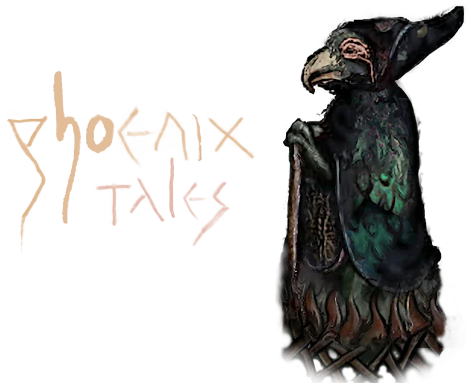
6. On the your YouTube channel we can find the trailer of a game named “Finster Demo” published by Mad Scientists at 1996, which you described as “Proto-GOTHIC”. Is this game based on the conception of “Gothic” from 1995 about you wrote?
And how and when it happened, that Mad Scientists started to cooperate with Piranha Bytes? Under the video you wrote that pitched the demo, but to Greenwood Entertainment.
For sure, they had initially different visions of a game, which they wanted to release. The release trailer of Finster Demo doesn’t have significant similarities to Gothic, so their idea was abandoned?
No, the Finster Demo was not published in 1996. The Demo was developed in 1996. It was published by us, after receiving it from the Mad Scientists, at September 17, 2022, as you can read in the Archive.
No, this demo is not based on Gothic. The Mad Scientists developed it on their own before having any publisher or any other developer. They presented it to publishers and the plan was to develop an rpg based on this engine, called Space & Time, that the Mad Scientists wrote. Finster itself was not entirely serious, it was a rough concept mixing medieval and sci-fi tropes, where you would fight with swords, but also with laser guns etc. and it contained many jokes etc. It was not meant to be a game as such, just a proof of concept. But for example, the character Gorn was invented here, by them.
Later, as far as I remember, the very name Gothic was also coming from Bert Speckels, one of the Mad Scientists. When they joined forces with the later Piranha Bytes it was decided to start from scratch instead and realise the vision of Mike, Alex, Stefan and Tom. So they just had developed an engine already and now they started all over again and wrote a new, better engine for Gothic.
By the way: Björn Pankratz, the guy that many people associate with Gothic today, didn’t play ANY role in the conception of Gothic. He was not even part of the project at that phase. He joined during the development of Gothic in the Quality Assurance department and later he did a little bit of supportive writing and quest design, that’s it.
He was NOT a founder of Piranha Bytes, he was NOT one of the visionaries who came up with this setting or the story, nothing like that. This changed with Gothic 2, when the others, apart from Mike, were gone and he slowly started gaining more and more influence in the company. I want to mention this specifically because I do not like this misconception that seems to be very widespread. The real visionaries of Gothic do not get much recognition anymore. This is also one of the things that the Phoenix project is trying to do. Getting some more clarity in the historical development and the development of ideas and who is to credit for what.
7. Which role played “Sleeper’s Bann” book written by Alex Wittmann in the development of Gothic 1? Recently, we published the article which focuses on the differences between the book and released Gothic 1 – so, for readers, the subject is not entirely unfamiliar.
Alex Wittmann was a friend of Tom Putzki, one of the founders. And he started to write this book during the Orpheus stage of development. Thus it was based on the world map and the faction design as it was at that time in the conception phase. Of course it also contains a lot of original ideas by the author and some misconceptions too. For example, he knew that the Enlightened (later called Y’Berion) and the sect as a whole was inspired by Buddhism and Hindu Sects. They were even meant to wear red/orange robes originally.
So Alex, when imagening the Enlightened, thought of Buddha. But at that time, and I think still today, when imagening Buddha many think of the very fat, Chinese4 depiction of him. That is of course just a symbolic representation and has nothing to do with the historical Buddha, which was rather ascetic and thin. Just as the Enlightened in Gothic was meant to be.
So that is most likely why Alex described him as this very fat guy, while the actual idea for him was to be more similar to the historical Buddha. He was meant to be so aloof that he who wouldn’t eat anything if others wouldn’t remind him of doing so and offering him food.
Anyway: This story, which we know from official promotion material that we released in the Archive, was once meant to become an official Gothic novel, but it didn’t happen in the end, like so many other plans. Don’t know why.
Thank you for your questions and interest in the early vision of Gothic that we at PhoenixTales are comitted to. I hope your readers may find any interest in my walls of text. Have a nice day.
Summary
Flosha started to work on Gothic Alpha because of his Phoenix project – initially, however, his focus was on recreating Gothic Sequel. That’s why he started Gothic Archive – a site that serves to catalogue early Gothic content. The second part of the series is of no interest to him – moreover, he does not consider the game “Gothic 2” to be Gothic.
According to him, the leak of the Sequel was simply not a glorious event because of the way it was done. He also claims that Gothic’s original visionaries are no longer given much credit, something that the Phoenix project aims to change. Once completed, we will be able to play it as a separate game, just as we did with The Chronicles of Myrtana.
You can contact Flosha and others involved in the Phoenix project on their Discord.
In the next interview, we’ll get to know a passionate gamer called Alpha Researcher aka Phantom95. He has already been mentioned by both interviewees.
- I.e. “Alpha Reseacher” – the next interviewee of Gothic Alpha passionates series. ↩︎
- So Michael Hoge, Stefan Nyul, Alex Brüggemann and Tom Putzki. ↩︎
- The language provided by Gothic engine, which allows to create the quests, NPCs, dialogues etc. in Gothic and its modifications. ↩︎
- It is a representation of Budai, a Chinese monk (ed. note.) ↩︎
